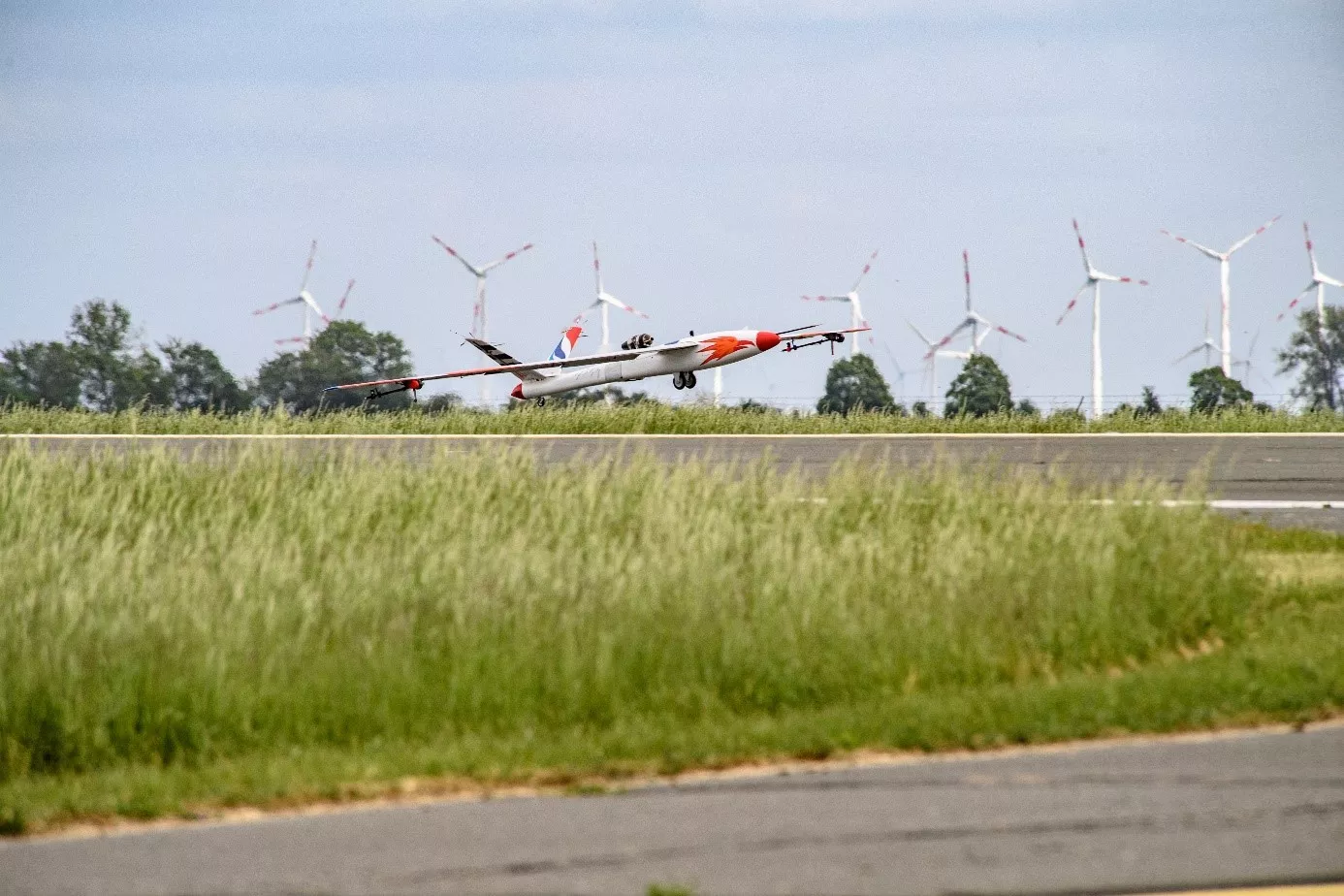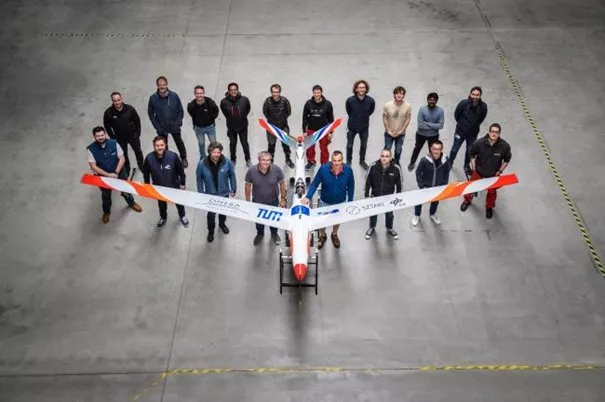Led by the HUN-REN Institute for Computer Science and Control (HUN-REN SZTAKI), a European research team has succeeded in overcoming an important challenge in aeroelasticity, that is, suppressing the flutter phenomenon in an aircraft structure by means of an active control system. This feat was demonstrated in a flight campaign using a specially constructed Unmanned Aerial Vehicle (UAV). The new method can be utilized as an effective technology for next-generation commercial aircraft. Funded under the EU Horizon 2020 framework, FliPASED (Flight Phase Adaptive Aero-Servo-Elastic Aircraft Design Methods) project is implemented through the collaboration between HUN-REN SZTAKI, the German Aerospace Center (Deutsches Zentrum für Luft- und Raumfahrt, DLR), the French Aerospace Lab (ONERA), and the Technical University of Munich (TUM) in Germany.
Flutter in aircraft
Aircraft are designed using technologies that enable lightweight construction in order to reduce their carbon footprint through lower fuel consumption. Consequently, aircraft structures are flexible, meaning they deform when subjected to aerodynamic loads. According to current trends, materials and design improvements will allow future aircraft to become even lighter, further increasing their flexibility.
This interplay between structural deformation and aerodynamics is called aeroelasticity. With increasing flexibility, the structural dynamics of the aircraft, that is, the characteristics of its vibration, start to be involved in certain phenomena. Under specific conditions, the interactions between the vibrations of an aircraft’s structure and the surrounding airflow can become unstable. This well-known aeroelastic phenomenon, referred to as ‘flutter’, may lead to catastrophic failure due to a rapid increase in the vibration amplitude. Therefore, an aircraft’s structure must be designed such that flutter can never occur at or below its maximum operating speed, with a significant margin. This crucial requirement poses a considerable constraint on making aircraft structures even lighter.

Led by HUN-REN SZTAKI, an international team of researchers has succeeded in overcoming one of the greatest challenges in aviation: they have actively suppressed the dreaded phenomenon of flutter with a sophisticated control system.
Within the Flight Phase Adaptive Aero-Servo-Elastic Aircraft Design Methods (FliPASED) project, one of the main goals was to suppress flutter by active means, using on-board control surfaces, sensors and smart control algorithms. The aim was to investigate to what extent this principle of active flutter suppression allows for new design freedom to further reduce the structural weight of the aircraft.
Realising this goal involved several key tasks: developing methods and tools for accurate flexible-aircraft modelling; developing aircraft control algorithms to enable flying beyond the design flutter speed; and validating the developed tools and methods on a safe and affordable experimental test platform.
T-FLEX and P-FLEX UAVs
The T-FLEX UAV was designed within an earlier European research project called Flutter Free Flight Envelope eXpansion (FLEXOP). The rationale behind such a demonstration is that different technologies can be tested relatively quickly and safely on a test-bench, at a fraction of the cost of adapting a flying commercial aircraft, and with no risk to human life. The second version of the UAV, P-FLEX, was used for testing active flutter control. As an additional safety device for flight testing, a flutter stopper system operated by the pilots was also implemented, which is an important safety feature.
Flight test at Cochstedt
The flutter flight test is a critical evaluation of an aircraft to assess its aeroelastic stability. It involves subjecting an aircraft to controlled and systematic tests to assess its performance under various flight conditions. The flutter test is an important milestone in every aircraft’s certification campaign as it helps identify and mitigate the risk of flutter, which can lead to catastrophic structural failure if left unaddressed.
The goals of the flutter flight test campaign conducted at the DLR National Experimental Test Center for Unmanned Aircraft Systems in Cochstedt (Germany) were to confirm the predicted open loop flutter speed (flutter speed without the use of active flutter controllers) and to demonstrate two active flutter suppression controllers beyond this open loop flutter speed. Teams from all project partners were present during the test week since it was clear that the success of the flutter flight tests would only be possible with a multidisciplinary team effort.
The week kicked off with an intensive team effort to update the aeroelastic models using the latest Ground Vibration Test (GVT) data. Based on these models, different analysis methods were employed to validate the expected flutter behaviour and to predict the actual flutter speed as accurately as possible. The flutter mechanism involved conventional bending-torsion coupling, which was expected, with considerably confidence, to become unstable at 56 metres per second. Next, the model was used to clear the controllers for flight testing by means of a large number of simulations.

The team made a UAV fly in areas that would not have been possible without the flutter suppression system. The successful flight tests took place at the National Experimental Test Center of Unmanned Aircraft Systems of DLR, located at Cochstedt.
The flight test plan was designed based on these results. It was decided to perform an open loop flight test at constant altitude with increasing flight speed. The aircraft was prepared, and the autopilot system allowed it to maintain the target flight speeds. From the open loop flight test to 54 metres per second, the results of data-driven Operational Modal Analysis (OMA) algorithms confirmed the occurrence of the coupling phenomenon between the symmetric wing bending and wing torsion modes predicted by the simulation models. In addition, the damping of the flutter critical mode was seen to reduce to under one percent of aeroelastic damping, indicating that 54 metres per second was indeed right on the edge of the stable flight envelope.
Flying beyond flutter speed
The next step was to test the active flutter controllers. Two different active flutter controllers were designed, a structured H-infinity controller and an H2-optimal input-output-blend control design. It was decided to perform a dedicated flight test for each controller, where the aircraft would surpass the predicted flutter speed of 56 metres per second. The airport, the firefighters and the FliPASED team were well prepared to take this calculated risk, with several contingency plans in the case of possible failure. The aircraft took off on Friday, 26 May 2023 at 09:50 and, after a system check, the active flutter control system was switched on. The aircraft was then safely flown beyond the flutter speed. Both controllers allowed the aircraft to be flown up to a speed of 61 metres per second, well above the critical speed, marking a crucial achievement for the project.
However, one important question still remained. Does the aircraft really have the expected destructive flutter phenomenon at 56 metres per second? The decision was then made to fly beyond the predicted flutter speed without a controller, in order to confirm the results of the simulation models and data-driven OMA algorithms. Several safety protocols were again put in place. During the flight, as it reached 56 metres per second earlier than expected due to highly turbulent conditions, the aircraft did experience flutter, resulting in damage and the loss of the aft-positioned beams on the wing, which were installed to induce flutter in the first place. This unintentional fail-safe feature saved the aircraft and allowed it to land safely without further incident. This final flight test confirmed that the controllers performed very well, and that active control can be an effective means to help lighter aircraft structures keep safe from flutter instability.
Outlook for the aerospace community
The flight tests demonstrated successful in-flight active flutter suppression on a UAV with characteristics similar to those of a commercial aircraft for the first time. This represents an unprecedented so-called technology readiness level, proving the feasibility of this method as an effective technology for next-generation commercial aircraft.
Since flutter is a dangerous and highly undesirable phenomenon, data on real flutter phenomena are extremely rare. The FliPASED project therefore has the vision not only to publish about flight hardware and software tools demonstrating active flutter control, simulation and real-time prediction, but also to provide an open-source repository with data from all flight tests. The goal is to allow other engineers and researchers to develop and validate their tools and methods, leading to the advancement of this field of research.
